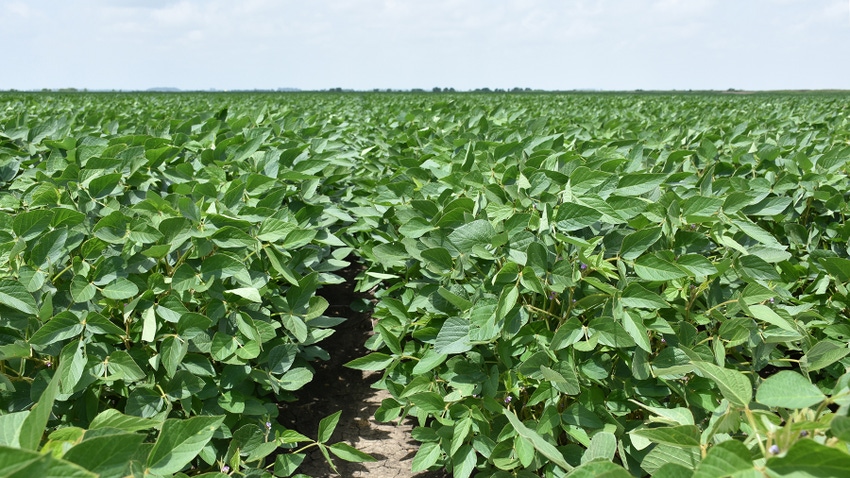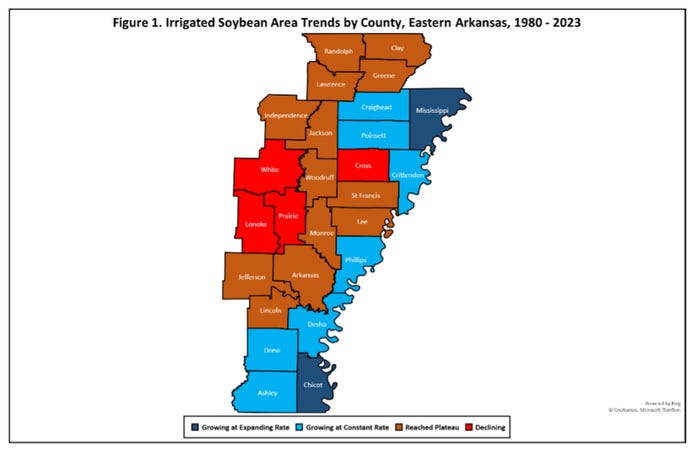
The Mid-South region - eastern Arkansas, northeast Louisiana, Mississippi, and southeast Missouri - experienced a significant expansion in irrigated soybean acres since the beginning of the 1980s.
Irrigated agriculture in this region is highly dependent on groundwater from the Mississippi River Valley alluvial aquifer. Eastern Arkansas is the largest soybean producer in the Mid-South.
From Census year 1982 to Census year 2017, Arkansas irrigated soybean area expanded by +2.108 million acres.
Every county in eastern Arkansas experienced an increase in irrigated soybean acres during this time, but counties experiencing the greatest expansion were those bordering the Mississippi River. Are irrigated soybean acres still expanding or are they beginning to level off in eastern Arkansas? Will irrigated soybean area expansion continue across the region?
Harvested acres
Area trend analysis was conducted to answer these questions. Irrigated soybean harvested acres data were collected for all 26 counties in eastern Arkansas for the period 1980 – 2018 from the USDA, National Agricultural Statistics Service.
Missing observations in the NASS data and additional acre observations for the period 2019 – 2023 were obtained from the USDA Farm Service Agency.

Figure 1 presents irrigated soybean acreage trends for the 1980 – 2023 period. Three basic patterns of acreage trends are identified:
Reached Plateau
Counties shaded orange represent counties that achieved a plateau at some point during 1980 – 2023 period. Irrigated soybean acres for these counties increased and then leveled off during the 44-year period.
Declining
Counties shaded red represent counties where irrigated soybean acres initially increased until an acre maximum was reached. After the acre maximum was reached, irrigated soybean acres began to decline.
Growing
Finally, counties shaded either light blue or dark blue represent counties where acres continue to grow and do not appear to have reached a plateau. The counties shaded light blue are counties with acres growing at a constant rate over time. The constant rate of growth ranged from +0.65 acres per year (Drew County) to +3.79 acres per year (Phillips County).
The dark blue counties (Chicot and Mississippi) represent counties where the rate of growth is not constant but expanding over time, with the most recent rate of growth reaching +5.26 acres per year for Chicot County and +7.23 acres per year for Mississippi County.
What information can be gleaned from these trends? Irrigated soybean acres in counties shaded red or orange are either declining (the red counties) or leveling off (the orange counties), implying irrigated area expansion in these counties has likely ended.
Most of these counties are located in Critical Groundwater Areas where groundwater is being depleted faster than the rate of recharge.
In addition, many of these counties have converted nearly all available non-irrigated soybean acres to irrigated acres.
Counties shaded either light blue or dark blue are still expanding in soybean irrigated area. Most of these counties are located either alongside or within close proximity to the Mississippi River, where groundwater is more plentiful.
Also, most of these counties still have a considerable amount of non-irrigated soybean area left for future irrigation conversion.
These results highlight the importance of both groundwater availability and land availability to continued future sustainability of soybean production in eastern Arkansas and by implication the Mid-South region.
Source: Southern Ag Today, a collaboration of economists from 13 Southern universities.
Read more about:
IrrigationAbout the Author(s)
You May Also Like




